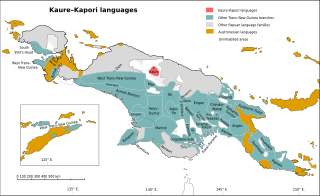Related Research Articles

The Papuan languages are the non-Austronesian languages spoken on the western Pacific island of New Guinea, as well as neighbouring islands in Indonesia, Solomon Islands, and East Timor. It is a strictly geographical grouping, and does not imply a genetic relationship.
The Sko or Skou languages are a small language family spoken by about 7000 people, mainly along the Vanimo coast of Sandaun Province in Papua New Guinea, with a few being inland from this area and at least one just across the border in the Indonesian province of Papua.

The East Geelvink Bay or East Cenderawasih languages are a language family of a dozen Papuan languages along the eastern coast of Geelvink Bay in Indonesian Papua, which is also known as Sarera Bay or Cenderawasih.
The Lakes Plain languages are a family of Papuan languages, spoken in the Lakes Plain of Indonesian New Guinea. They are notable for being heavily tonal and for their lack of nasal consonants.
The Yuat languages are an independent family of five Papuan languages spoken along the Yuat River in East Sepik Province, Papua New Guinea. They are an independent family in the classification of Malcolm Ross, but are included in Stephen Wurm's Sepik–Ramu proposal. However, Foley and Ross could find no lexical or morphological evidence that they are related to the Sepik or Ramu languages.
The Burmeso language – also known as Taurap – is spoken by some 300 people in Burmeso village along the mid Mamberamo River in Mamberamo Tengah subdistrict, Mamberamo Raya Regency, Papua province, Indonesia. It is surrounded by the Kwerba languages to the north, the Lakes Plain languages to the south, and the East Cenderawasih Bay languages to the west.

The Yawa languages, also known as Yapen languages, are a small family of two closely related Papuan languages, Yawa and Saweru, which are often considered to be divergent dialects of a single language. They are spoken on central Yapen Island and nearby islets, in Cenderawasih Bay, Indonesian Papua, which they share with the Austronesian Yapen languages.

The South Halmahera–West New Guinea (SHWNG) languages are a branch of the Malayo-Polynesian languages, found in the islands and along the shores of the Halmahera Sea in the Indonesian province of North Maluku and of Cenderawasih Bay in the provinces of Papua and West Papua. There are 38 languages.
Warembori is a moribund language spoken by about 600 people in Warembori village, Mamberamo Hilir District, Mamberamo Raya Regency, located around river mouths on the north coast of Papua, Indonesia.
Iau or Turu is a Lakes Plain language of West Papua, Indonesia, spoken by about 2,100 people, native speakers of this language are the Turu people (Iau). Most speakers are monolingual, and their number is growing. Other peoples in the western Lakes Plain area speak basic Iau. Iau is heavily tonal, with 11 tones on nouns and 19 simple and compound tones on verbs.
Pyu is a language isolate spoken in Papua New Guinea and Indonesia. As of 2000, the language had about 100 speakers in Papua New Guinea. It is spoken in Biake No. 2 village of Biake ward, Green River Rural LLG in Sandaun Province. Additionally, there are about 150 speakers in Batom District, Pegunungan Bintang Regency, Highland Papua, Indonesia.
Namla is a poorly documented Papuan language of Indonesia. It appears to be related to Tofanma, a neighboring language. It is spoken in Namla village, Senggi District, Keerom Regency.
Murkim is a Papuan language of Western New Guinea, near its relatives Lepki and Kembra. Though spoken by fewer than 300 people, it is being learned by children. It is spoken in Murkim District, Pegunungan Bintang Regency, Papua Province, Indonesia.
Yawa (Yava) is the Papuan language of central Yapen Island in Geelvink (Cenderawasih) Bay, Indonesia. Alternative names are Iau, Mantembu, Mora, Turu, and Yapanani.
Saweru is a Papuan language closely related to Yawa of central Yapen Island in Geelvink (Cenderawasih) Bay, Indonesia, of which it is sometimes considered a dialect. It is spoken on Serui Island just offshore.

Kaure is a Papuan language of West Papua. It is spoken in the villages of Lereh, Harna, Wes, Masta, and Aurina.
Kwerba is a Papuan language of Indonesia. Alternate names are Airmati (Armati), Koassa, Mataweja, Naibedj, Segar Tor, Tekutameso.
The South Pauwasi languages are a likely small language family of New Guinea, potentially consisting of Yetfa, Kimki, Lepki, Murkim and Kembra.
Øystein Lund Andersen is a Norwegian photographer and writer.
The Lepki–Murkim languages are a pair to three recently discovered languages of New Guinea, Lepki, Murkim and possibly Kembra.
References
- ↑ Lepki at Ethnologue (18th ed., 2015) (subscription required)
- ↑ "Glottolog 4.4 - Andersen, Øystein Lund 2007".
- ↑ Andersen, Øystein Lund (July 2007). "The Lepki people of Sogber River, New Guinea" (PDF). Cenderawasih University. Archived from the original (PDF) on 27 January 2018.
- ↑ Foley, William A. (2018). "The languages of Northwest New Guinea". In Palmer, Bill (ed.). The Languages and Linguistics of the New Guinea Area: A Comprehensive Guide. The World of Linguistics. Vol. 4. Berlin: De Gruyter Mouton. pp. 433–568. ISBN 978-3-11-028642-7.